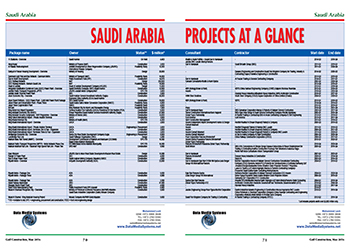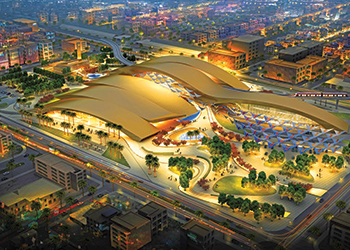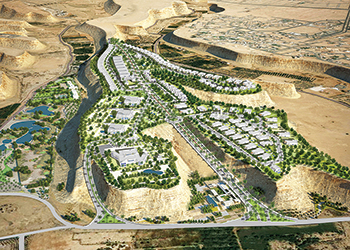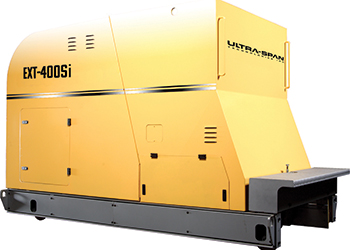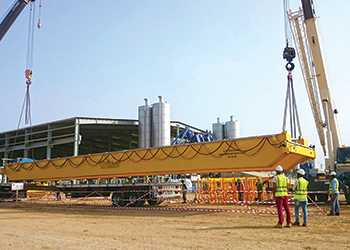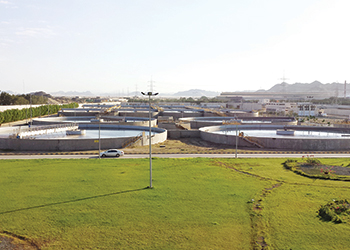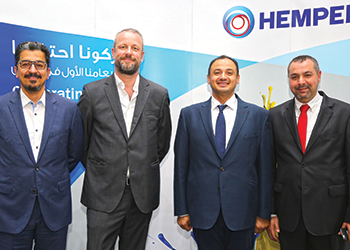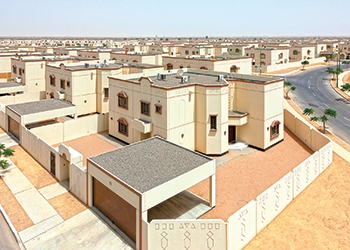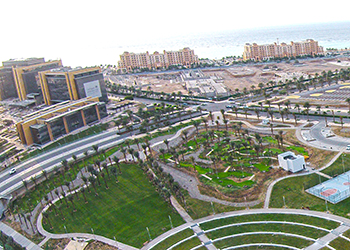
 The KAEC ... significant growth.
The KAEC ... significant growth.
Armed with a transformation plan, Saudi Arabia is eyeing growth and investment, which spells good news for the construction sector
As plunging oil revenues and spending cuts cast gloom on the Saudi construction horizon, the silver lining is that the kingdom is now actively addressing its housing shortage and pushing ahead with some of its key infrastructure plans.
The market is understandably gloomy as the nation dips into its reserves to cover its budget deficit. It has, undoubtedly, been one of the toughest years that Saudi Arabia’s construction sector has seen against a backdrop of delays in payment of dues to contractors, a shortage of workers owing to the tightening of labour laws and a dearth of new projects. The conflict with its neighbours, both in Yemen and Syria, is a further damper that has sapped the confidence of the private sector.
This year marks the first time since 2002 that Saudi Arabia has budgeted a cut in spending to SR840 billion ($223.9 billion), compared to SR860 billion ($229.2 billion) for 2015.
According to a report by Faithful+Gould, a leading integrated project and programme management consultancy, Saudi Arabia’s construction sector is likely to spend $29.9 billion on development projects in 2016 with similar projections for the next year, with the spend forecast being is 20 per cent less than the previous year’s budget (see Saudi Focus).
In view of the financial squeeze, the country has initiated a number of austerity measures; for instance, the Ministry of Finance has amended its advanced payment policy for contractors, paying five per cent of the contract value in advance instead of 20 per cent as in previous years. Saudi ministries have reportedly been instructed to cut their spending on contracts by at least five per cent. In addition, a number of projects are either being scaled down and revised or put on hold indefinitely.
Nevertheless, the largest construction market in the Middle East – where projects worth an estimated $400 billion are currently under construction or in the pre-construction phases – continues to provide opportunities for growth particularly in affordable housing, and the infrastructural and tourism sectors.
This is evident from the major $20-billion deal that has just been awarded to build 100,000 homes in the kingdom (see Saudi Focus) and the fact that works on key infrastructural developments, such as the $23-billion Riyadh Metro and those linked with the Hajj and Umrah pilgrimages, have suffered no setbacks. The kingdom needs to build a whopping 300,000 houses a year to meet its current demand.
According to BMI Research, Saudi Arabia has plans for some $124 billion worth of transportation projects, of which $51 billion are under construction including the Jeddah and Riyadh airport expansion programmes. The kingdom is also looking at privatising a number of airports, which could open up the sector for significant foreign investment.
Also, electricity, water and gas projects are expected to register robust growth to cope with the increased demand. Projects worth some $20 billion are expected to go on stream this year in this sector, including power plants in Jeddah and Yanbu.
In view of the slump in oil prices, Saudi Arabia has intensified its efforts to diversify its economy in a bid to expand its revenue streams and is increasing looking towards privatisation. With this in mind, the kingdom late last month announced its National Transformation Plan (NTP) to help drive the economy forward. The five-year NTP includes asset sales, tax increases, spending cuts, changes to the way the state manages its financial reserves, an efficiency drive, and a much bigger role for the private sector.
In addition, with the imposition of fees on undeveloped plots, land owners will be forced to develop their properties or sell them to real estate developers, creating a surge in activity in real estate development in the kingdom.
In the real estate sector, work continues on the Jeddah Tower – formerly known as Kingdom Tower, which forms the centrepiece of Jeddah Economic City and will be the world’s tallest tower at more than 1 km high on completion in 2019. Its developer the Saudi-based Jeddah Economic Company (JEC) has secured Shari’a-compliant financing of up to SR3.6 billion ($959.4 million) for Phase One of its 5.3-sq-km mixed-use city. Construction of the Jeddah Tower has now reached its 39th level.
Another mega development that has registered significant growth is the King Abdullah Economic City (KAEC), a special economic zone on the Red Sea coast, which is currently developing a number of residential communities such as Al-Talah Gardens and Beach Community. A landmark project that has suffered delays is the King Abdullah Financial District (KAFD), which could now be transformed into a special business zone in line with the National Transformation Plan.
Looking at the construction scenario over the past year, the total value of contracts awarded during 2015 amounted to SR223.4 billion ($59.5 billion), recording a 1.2 per cent increase compared to 2014, according to the NCB’s Construction Contracts Index for the fourth quarter of 2015. The contracts given out during the quarter declined by 25 per cent to SR45.6 billion ($12.2 billion), compared to the third quarter, with the bulk of the awards having been in the power, water, oil and gas and industrial sectors.
Link: Value of contracts by year (SR million)
The NCB’s construction contracts index (CCI) which has 2008 (January) as its base year with 100 points, ended the year at 260 points, indicating a slight increase of 10.80 per cent over 2014’s level of 234.48 points (Figure 1). According to the bank, the CCI exhibited volatile swings during 2015, but nonetheless settled relatively high at the end of the year. Looking ahead, the supply of new projects that are entering the execution phase appear to be steady as indicated by the CCI’s performance.
According to the report, last year the oil and the gas sector accounted for the bulk of the contracts awarded – about 36.6 per cent – worth SR81.8 billion ($21.8 billion), awarded by Saudi Aramco. Most of these mega-projects involved refineries, pipeline extensions and expansion of the master gas system. International contractors – mainly European and Asian – grabbed the lion’s share of these projects which were packaged in phases to ensure their timely completion.
The next largest sector to dominate the contracts scene was the power sector, issuing deals worth SR26.8 billion ($7.1 billion) in 2015, with Saudi Electricity Company (SEC) accounting for most of them, the NCB says. The report indicates that opportunities lie ahead for the sector as Saudi Aramco plans to enhance the power generation capacity of the Jizan Economic City by building multiple power plants.
Contracts worth SR30.5 billion ($8.1 billion) were awarded last year in the residential real estate sector, with the Ministry of Interior (MoI), followed by Saudi Aramco, having awarded most of these projects.
The healthcare sector awarded contracts valued at SR16.9 billion ($4.5 billion), most of which were for the construction of new hospitals across the kingdom, including Phase One of the Military Medical City in Riyadh and two hospitals in Taif and Jeddah.
The value of awarded contracts in the industrial sector rose to SR14.4 billion ($3.8 billion) in 2015. With the increasing number of private sector investors building new factories, the NCB anticipates further opportunities for local contractors in the industrial sector.
Housing
To tackle the kingdom’s pressing housing shortage, the Saudi government is setting up a new state-backed development company, according to Bloomberg.
The new firm will give businesses plots of land, and provide a mortgage guarantee fund that would serve as a useful method for bringing financing to schemes, the report states.
This strategic move by the government will breathe new life into a mass house-building plan that was announced by the late King Abdullah in 2011 to set aside SR250 billion ($66.6 billion) for the construction of half a million homes, the Saudi Arabia’s housing minister Majed Al Hogail was quoted as saying in the report.
According to an industry expert the new company was likely to be financed, in part, by the white land tax that was introduced in January.
Transport
Among the sectors that will register strong growth over the next five years is the transport infrastructure industry, with the rail sub-sector being the key growth driver as the government invests heavily in its logistics and public transport networks, said BMI Research.
This is because demands of a rapidly expanding population and the cyclical effects of a major influx of religious tourists are putting a huge strain on the existing transport network. Also in line with the kingdom’s efforts to diversify its economy, an effective transport network is seen as a key supporting factor to developing an industrial base.
BMI Research forecasts that the transport sector will grow in real terms by 7.5 per cent in 2016. This is due to the fact that Saudi Arabia has embarked on a major expansion of its railways and initiated plans to integrate with the GCC’s railway network and develop major public transport infrastructure. The Haramain High-Speed Railway, which links Makkah, Madinah and Jeddah, is at an advanced stage. Another project on the anvil is the construction of the much-awaited Saudi Landbridge, a 480-km high-speed railway line between Riyadh and Dammam.
Major emphasis has been placed recently on the development of metros in key cities of the kingdom. Three foreign consortiums are currently building the Riyadh Metro which has shown impressive progress with around 30 per cent of the work completed. The Makkah metro expansion award has suffered delayed but is nevertheless expected to go ahead.
A consortium comprising Egis and Systra is currently conducting design studies for the 95-km Madinah metro, which is slated to become operational in 2020. Meanwhile, the $12-billion Jeddah Metro, which is scheduled for completion in 2020, is in the early design stages.
Airports
Construction has reached an advanced on the expansion of King Abdulaziz International Airport in Jeddah International Airport. Under the first phase, which is being undertaken at a cost $7.2 billion, the airport will see its capacity boosted to 30 million passengers annually from the current 17 million. Spanning an area of 670,000 sq m, the airport will have two new terminals for domestic and international passengers. The facility is likely to be ready for international operations by the middle of 2017.
Work is also under way on the expansion of the King Khalid International Airport in Riyadh, which includes an upgrade and expansion of two terminals, the demolition and reconstruction of the aprons, construction of terminal lounges and operation buildings, and installation of baggage handling and security systems. The project, which is the first phase of the estimated $4.5 billion plan to develop the airport, is due to be completed in May 2019.
A new airport is also being built in Abha to accommodate five million passengers per year while another new facility has planned for Jizan.
According to BMI Research, Saudi Arabia is expected to use the privatisation of $1.2-billion Prince Mohammed Bin Abdul Aziz International Airport in Madinah as the template for pursuing its ambitions for its aviation sector. The facility, which is the first privately developed airport in Saudi Arabia, has been built under a 25-year build-operate-transfer (BOT) concession.
Meanwhile, a recent Reuters report indicates that the General Authority of Civil Aviation (GACA) is in talks with government agencies to set up free zones at Jeddah and Riyadh airports as part of a long-term plan to diversify the kingdom’s economy away from oil.
Outlook
According to Jawda Investment, the non-oil private sector will continue to grow albeit at a slower pace, as reduced government spending will most likely have a negative impact on business activity (Table 1). However, growth in all sectors in the non-oil private economy will remain positive at 2.6 per cent. The investment company predicts a growth of four per cent in the utilities sector, which will make it the fastest growing sector in the kingdom in 2016. Growth in the construction sector is forecast to slow down to two per cent. The investment company states that while contractors are expected to continue being impacted by public investment spending cuts, the sector will likely benefit from stimulated demand from the private sector, and particularly real estate development.
In its Saudi Arabia Infrastructure Report Q2 2016, BMI Research states that Saudi Arabia’s infrastructure and construction sectors have now settled into a period of lower growth and indicates that major projects that are strategically important will continue to be awarded and projects that currently in progress are unlikely to be halted.
BMI, however, sees real growth in the construction sector of 6.5 per cent year-on-year in 2016, anticipating a slight improvement in the performance of the sector as the wider Saudi economy adjusts to the new normal of lower oil prices, although financing pressures will remain high. The implementation of the new land tax should see landowners seek developers to undertake residential projects, it says.
According to the NCB, 2016 is expected to be a challenging year by all accounts, globally and in the kingdom. While the government will continue to spend on social and physical infrastructure projects, the level of spending will inevitably be reduced over the medium term.
Among the measures taken by the government to address the financial constraint it has been facing is dipping into its foreign reserves, reducing fuel subsidies and even taking a loan. The NCB also expects the government to resort to public-private partnership schemes to finance infrastructure projects over the medium term.





















_0001.jpg)


.jpg)
















.jpg)








.jpg)



